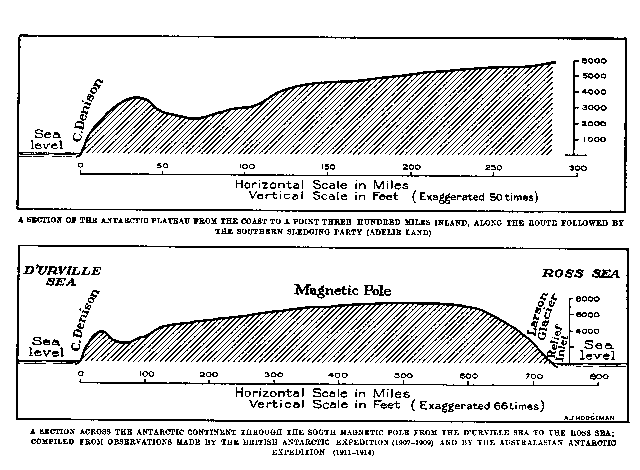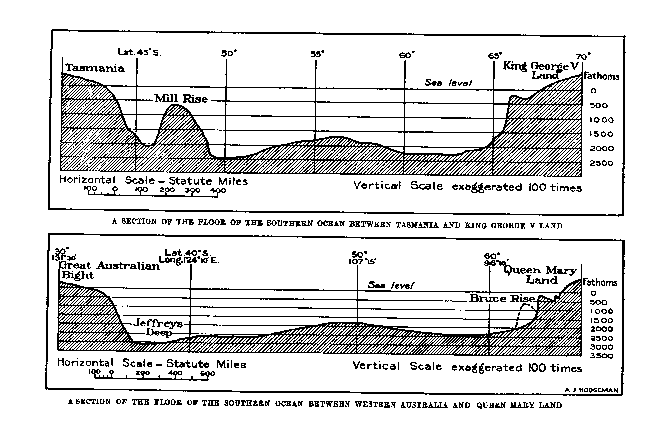Appendix 2 - Scientific Work
The Home of the Blizzard
By Douglas Mawson
Appendix 1 - The Men of the Expedition has been incorporated in to this expanded section
Preface
Chapters:
1 - The Problem
and Preparations |
2 - The Last
Days of Hobart and the Voyage to Macquarie Island |
3 - From Macquarie
Island to Adelie Land |
4 - New Lands
| 5 - First
Days in Adelie Land |
6 - Autumn
Prospects |
7 - The Blizzard |
8 - Domestic
Life | 9
- Midwinter and its Work |
10 - The
Preparation of Sledging Equipment |
11 - Spring
Exploits |
12 - Across King George V Land |
13 - Toil
and Tribulation |
14 -
The Quest of the South Magnetic Pole
| 15
- Eastward Over the Sea-Ice |
16 - Horn
Bluff and Penguin Point |
17 - With
Stillwell's and Bickerton's Parties |
18 - The
Ship's Story |
19 - The
Western Base - Establishment and Early Adventures |
20 - The
Western base - Winter and Spring |
21 - The
Western Base - Blocked on the Shelf-Ice |
22 - The
Western base - Linking up with Kaiser Wilhelm II Land
| 23 - A
Second Winter |
24 - Nearing
the End |
25 - Life on Macquarie Island |
26 - A Land
of Storm and Mist |
27- Through
Another Year |
28 - The
Homeward Cruise
Appendices:
2 - Scientific Work
| 3 - An Historical
Summary | 4
- Glossary |
5 - Medical Reports |
6 - Finance
| 7 - Equipment
Summary (2 pages) of the
Australian Antarctic Expedition
| The
Men of the Expedition
It should be remarked that there is no intention
of furnishing anything more than a suggestion of the general trend
of the scientific observations of the Expedition. The brief statement
made below indicates the broad lines on which the work was conducted
and in some cases the ground which was actually covered. It may
thus give the general reader a clue to the nature of the scientific
volumes which will serve to record permanently the results amassed
during a period of more than two years.
Terrestrial
Magnetism
1. Field Work.
(a) Dip determinations
were made at Macquarie Island, on the eastern and southern journeys
from the Main Base (Adelie Land) and on a short journey from the
Western Base (Queen Mary Land).
(b) Declination by theodolite
observations was determined at Macquarie Island and at intervals
on all sledging journeys in the Antarctic.
(c) Rough observations
of magnetic variation were made daily on the `Aurora' during
her five cruises.
2. Station Work.
(a) Regular magnetograph
records were kept at the Main Base (Adelie Land) for a period of
eighteen months. A system of term days for quick runs was also followed;
Melbourne, Christchurch, and other stations co-operating. In connexion
with the magnetograph work, Webb conducted regular, absolute observations
throughout the year 1912. Bage continued the magnetograph records
for a further six months in 1913, observed term days, and took absolute
observations.
(b) At the Western Base (Queen Mary Land) Kennedy
kept term days in the winter, using a magnetometer and dip-circle.
Biology
1. Station Collections.
(a)
At Macquarie Island, Hamilton worked for two years amongst a rich
fauna and a scanty but interesting flora. Amongst other discoveries
a finch indigenous to Macquarie Island was found.
(b) In
Adelie Land, Hunter, assisted by Laseron, secured a large biological
collection, notwithstanding the continuous bad weather. Dredgings
from depths down to fifty fathoms were made during the winter. The
eggs of practically all the flying birds known along Antarctic shores
were obtained, including those of the silver-grey petrel and the
Antarctic petrel, which were not previously known; also a variety
of prion, of an unrecorded species, together with its eggs.
(c) At the Western Base (Queen Mary Land) eggs of the Antarctic
and other petrels were found, and a large rookery of Emperor penguins
was located; the second on record. Harrisson, working under difficulties,
succeeded in trapping some interesting fish on the bottom in two
hundred and fifty fathoms of water.
2. Ship Collections.
(a) A collection made by Mr. E. R. Waite, Curator of the Canterbury
Museum, on the first Sub-Antarctic cruise.
(b) A collection
made by Professor T. T. Flynn, of Hobart, on the second Sub-Antarctic
cruise.
(c) A collection made by Hunter, assisted by Hamilton,
in Antarctic waters during the summer of 1913-1914. This comprised
deep-sea dredgings at eleven stations in depths down to one thousand
eight hundred fathoms and regular tow-nettings, frequently serial,
to depths of two hundred fathoms. Six specimens of the rare Ross
seal were secured. A large collection of external and internal parasites
was made from birds, seals and fish.
Geology
(a) A geological examination of Macquarie Island was made by
Blake. The older rocks were found to be all igneous. The Island
has been overridden in comparatively recent times by an ice-cap
travelling from west to east.
(b) Geological collections
at the Main Base. In Adelie Land the rocky outcrops are metamorphic
sediments and gneisses. In King George V Land there is a formation
similar to the Beacon sandstones and dolerites of the Ross Sea,
with which carbonaceous shales and coaly strata are associated.
(c) Stillwell met with a great range of minerals and rocks in
the terminal moraine near Winter Quarters, Adelie Land. Amongst
them was red sandstone in abundance, suggesting that the Beacon
sandstone formation extends also throughout Adelie Land but is hidden
by the ice-cap. A solitary stony meteorite was found by a sledging
party lying on the ice of the plateau.
(d) In the collections
made by Watson and Hoadley at the Western Base (Queen Mary Land)
gneisses and schists were ascertained to be the predominant types.
(e) A collection of erratics was brought up by the deep-sea
trawl in the course of dredgings in Antarctic waters.
Glaciology
(a) Observations of the pack-ice, coastal
glaciers and shelf-ice from the `Aurora' during her three Antarctic
cruises.
(b) Observations of the niveous and glacial features
met with on the sledging journeys from both Antarctic bases.
Meteorology
(a) Two years' observations
at Macquarie Island by Ainsworth
(b) Two years' observations
in Adelie Land by Madigan.
(c) One year's observations
in Queen Mary Land by Moyes.
(d) Observations by the Ship
on each of her five voyages.
(e) Observations during the
many sledging journeys from both Antarctic Bases.
Bacteriology, etc.
In Adelie Land, McLean carried out
many months of steady work in Bacteriology, Haematology and Physiology.
Tides
Self-recording instruments were run
at Macquarie Island by Ainsworth and at Adelie Land by Bage.
Wireless and Auroral Observations
A very close
watch was kept upon auroral phenomena with interesting results,
especially in their relation to the ``permeability'' of
the ether to wireless waves.
Geographical Results
1. The successful navigation by the `Aurora' of the Antarctic
pack-ice in a fresh sphere of action, where the conditions were
practically unknown, resulting in the discovery of new lands and
islands.
2. Journeys were made over the sea-ice and on the
coastal and upland plateau in regions hitherto unsurveyed. At the
Main Base (Adelie Land) the journeys aggregated two thousand four
hundred miles, and at the Western Base (Queen Mary Land) the aggregate
was eight hundred miles. These figures do not include depot journeys,
the journeys of supporting parties, or the many miles of relay work.
The land was mapped in through 33 degrees of longitude, 27 degrees
of which were covered by sledging parties.
3. The employment
of wireless telegraphy in the fixation of a fundamental meridian
in Adelie Land.
4. The mapping of Macquarie Island.

A Section of the Antarctic Plateau from the
Coast to a Point Three
Hundred Miles Inland, along the Route
followed by the Southern
Sledging Party (Adelie Land)
A Section across the Antarctic Continent through the South Magnetic
Pole from the D'Urville Sea to the Ross Sea; Compiled from Observations
made by the British Antarctic Expedition (1907-1909) and by the
Australian Antarctic Expedition (1911-1914)
Oceanography
1. By soundings the fringe
of the Antarctic Continent as well as the Continental Shelf has
been indicated through 55 degrees of longitude.
2. The configuration of the floor of the ocean southward
of Australia and between Macquarie Island and the Auckland Islands
has been broadly ascertained.
3. Much has been done in the
matter of sea-water temperatures and salinities.

A Section of the Floor of the Southern Ocean
between Tasmania
and King George V Land
A Section of the
Floor of the Southern Ocean between Western
Australia and Queen
Mary Land
APPENDIX - 3 HISTORICAL SUMMARY
